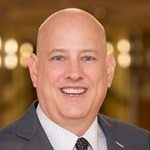Stroke Center
Welcome to the Clinical Neuroscience Institute’s Stroke Center
The specialists at the Clinical Neuroscience Institute’s Stroke Center are skilled and experienced in comprehensive stroke care. Our board-certified surgeons are trained in the care of stroke and interventional procedures that may limit stroke damage and save a patient’s life.
At the Clinical Neuroscience Institute’s Stroke Center, we offer coordinated, multidisciplinary care that allows us to lead the region in stroke emergency response and treatment. Our professional, highly-qualified staff includes neurologists, neurocritical care specialists, neurointerventional surgeons, neurology nurse specialists, and occupational, physical, and speech therapists who are available to provide emergency care, treatment, and recovery from the different types of stroke.
Our Stroke Center is equipped with advanced technology to effectively and swiftly diagnose stroke when timing is essential. We employ the use of our Telestroke Network to connect specialists across the Premier Health system to provide diagnosis and treatment options from remote locations to the point of care, saving time and providing treatment when moments count. The Stroke Center uses Solitaire technology to treat hemorrhagic stroke, a clot-removal system that restores blood flow to the brain minutes after a stroke happens.
We are dedicated to caring for you when a stroke happens, treating you after it occurs, helping you recover, and partnering with you in prevention of stroke. At the Clinical Neuroscience Institute’s Stroke Center, we value your quality of life and are dedicated to supporting your wellness.
The physicians and staff of the CNSI’s Stroke Center provides services at all Premier Health hospitals. Premier Health provides stroke care that has earned national recognition. Miami Valley Hospital has attained certification as a Comprehensive Stroke Center by The Joint Commission.
Stroke services at all Premier Health hospitals and emergency centers are designed to foster better outcomes for stroke care. Atrium Medical Center and Upper Valley Medical Center are certified as Advanced Primary Stroke Centers by The Joint Commission. Miami Valley Hospital South is a certified acute stroke ready hospital.
Aneurysm and Other Brain Vascular Conditions
When problems occur with the blood vessels in the brain, neck, and spine, the cerebrovascular team at Premier Health provides advanced care when minutes matter.
Cerebrovascular conditions and diseases lead to various types of stroke, including:
- Strokes from lack of blood flow to the brain
- Strokes from bleeding in the brain and spine
When these conditions occur, immediate, specialized, and comprehensive care is needed to save lives and improve patient outcomes. Your care team includes:
- Emergency medicine doctors
- Neurologists
- Neurosurgeons
- Neurointerventional specialists
- Neurocritical care specialists
- Neuroradiologists
- Rehabilitation specialists
- Specially trained nurses and staff
Our experts work together to provide the best patient care in the region for patients with vascular disorders of the brain and spine.
Types of Vascular Conditions We Treat
A brain aneurysm occurs when a blood vessel wall inside the brain pouches out. This is a weak spot in the vessel wall that could grow and rupture, leading to bleeding in the brain and inside the skull.
Other cerebrovascular conditions include:
- Stroke. There are various types of strokes. The most common occur when a clot blocks a blood vessel in the brain, stopping blood flow and causing brain injury. Other types of stroke may be caused by bleeding in the brain and brain coverings.
- Arteriovenous malformations. These are abnormal tangles of blood vessels located in the brain that can lead to bleeding.
- Hemorrhage. (bleeding) in the brain and spine
- Carotid artery disease. A narrowing of the carotid artery (the main blood vessel located in the neck on each side, which carries blood towards the brain).
- Intracranial stenosis. Narrowing in arteries in the brain that could lead to reduced blood flow to the brain and subsequently cause a stroke
- Atherosclerosis. Thickening or hardening of artery walls from plaque buildup.
- Cerebral vasospasm. A special type of narrowing of the arteries in the brain that may reduce blood flow and cause stroke-like symptoms. Vasospasm often occurs after an aneurysm or hemorrhagic stroke
- Other vascular anomalies in the brain and spine
- Brain tumors. Brain tumors can contain an increased amount of blood vessels that can lead to bleeding.
Aneurysm Risks and Symptoms
Most aneurysms do not usually cause symptoms. There are several factors that increase your risk for an aneurysm bleeding, such as:
- High blood pressure
- Heavy lifting or straining
- Smoking
- Medications, including blood thinners and diet pills
- Stress or anger leading to increased blood pressure
If you’ve been diagnosed with an aneurysm, talk with your doctor about how to manage your condition.
If an aneurysm grows, symptoms may occur, including:
- Severe headaches
- Vision changes
- Pain behind the eye
- Nausea and/or vomiting
If an aneurysm begins to bleed or ruptures, it can be life threatening. Symptoms can include:
- A sudden, severe headache (worst you’ve ever had) that lasts several hours or days
- Seizures
- Nausea or vomiting
- Vision problems
If you have these symptoms, get to an emergency room right away or call 911. Rapid care can protect brain functions and save your life.
Diagnosing Cerebrovascular Conditions
Our cerebrovascular team works together quickly to spot any conditions, such as an aneurysm or blood clot, that can lead to a stroke or bleeding in the brain.
Different tests can check the health of the brain’s vessels, including:
- MRA (magnetic resonance angiography)
- CTA (computed tomography angiography)
- Catheter based angiography with 3D imaging, to pinpoint the location of an aneurysm.
- Ultrasound imaging to show the location of an aneurysm or damaged vessels and surrounding tissue.
- Transcranial Doppler
- PET/CT (positron emission tomography)
- Brain perfusion scan with RAPID™ imaging. This is a new technological advance that allows computer software to read various patterns of blood flow in the brain, providing an immediate and automated brain map of blood flow supply, allowing immediate care for patients having a stroke.
Advanced Treatments
The treatment of bleeding – or potential bleeding — in the brain and head requires specialized training and technology. Our neurointerventional doctors provide lifesaving medical and surgical techniques, including minimally invasive endovascular rescue procedures to restore proper brain blood flow and and/or stop brain bleeding while minimizing complications.
These procedures do not require opening the skull or cutting brain tissue, and are performed through a small incision in the groin, allowing catheters to be navigated from this site all the way to the target lesion in the brain.
Possible treatments include:
- Thrombectomy for brain revascularization. This procedure is performed to open a blocked blood vessel in the brain. The neurointerventional specialist threads a catheter through an artery in the groin and navigates it to the blocked artery in the brain. A tiny wire mesh tube (retrievable stent) opens in the blocked artery and restores blood flow. The clot sticks to the stent and is removed by the catheter in combination with suction devices used at the site of the clot. This revascularization treatment can be used up to six hours after stroke symptoms begin, and up to 24 hours in some patients, depending on special criteria.
- Stenting procedures that use thin wire mesh tubes to open up narrowed blood vessels and allow blood flow to the brain to return or improve. Types include:
- Carotid artery stenting
- Intracranial artery stenting
- Coil embolization is used to repair aneurysms in the brain. This is a minimally invasive procedure in which the neurointerventional specialist threads a catheter through an artery in the groin and navigates it to the damaged blood vessel in the brain where the aneurysm is located. Tiny coils are placed inside the aneurysm, filling the open space and sealing it from the inside, therefore stopping blood from entering the aneurysm and stopping any bleeding from this site.
- Woven EndoBridge (WEB) Aneurysm Embolization is a self-expanding mesh ball implant used for the treatment of wide-neck bifurcation aneurysms (where the artery splits into two branches). The mess ball acts as a plug inside the space of the aneurysm reducing the blood flow and prevents any further bleeding.
- Aneurysm clipping. This procedure is used to repair brain aneurysms that cannot be treated with coils. The neurointerventional specialist removes a small piece of the skull to access the brain and remove any trapped blood. A clip is placed on the aneurysm to prevent bleeding.
- Pipeline™ embolization is a procedure in which a mesh tube (flow diverter) is used to shift blood flow away from the aneurysm or damaged blood vessel, stopping blood from entering the aneurysm and thereby stopping the bleeding.
- Embolization procedures that use tiny beads or other substances like liquid glue to close off or block a blood vessel and treat conditions such as:
- Arteriovenous malformations
- Brain aneurysms
- Vascular malformations of the brain and spine
- Tumors of the brain and spine
- Uncontrolled nose bleeds
- Revascularization procedures to restore blood flow to the head, neck and brain, including:
- Bypass procedures to reroute blood flow around a damaged blood vessel
- Surgery to remove clots from the brain and spine
- Stereotactic radiosurgery to treat and destroy arteriovenous malformations and brain tumors.
- Control of intracranial pressure using medicine and procedures to drain extra fluid or blood from the brain. In rare cases, this requires removing part of the skull temporarily to ease pressure in the skull.
Detection and Prevention
The fellowship-trained and board-certified physicians and professional staff at the Clinical Neuroscience Institute’s Stroke Center are dedicated to the comprehensive diagnosis, treatment, and prevention of the different types of stroke. Learn more .
FAQs
Find answers to CNSI Stroke Center frequently asked questions. Learn more.
How to Reach Us
We make it easy for you to find care at the Clinical Neuroscience Institute’s Stroke Center. Learn more about how to reach us.
Our Team
Meet our team at the Clinical Neuroscience Institute’s Stroke Center.
Our Physicians










